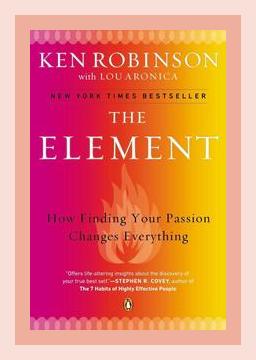Innovation and CreativityCreativity in Business
**
Introduction
“The Element: How Finding Your Passion Changes Everything” by Ken Robinson is a profound exploration of human potential and creativity. The book delves into the concept of “The Element,” which Robinson defines as the point where natural talent and personal passion intersect, resulting in true fulfillment and achievement. Robinson advocates for creating environments that nurture creativity and emphasizes that finding one’s Element is crucial for both individual satisfaction and societal growth. Below is a detailed summary of the book’s major points, supplemented with concrete examples and specific actions readers can take to apply these insights.
1. The Element Defined
– Point: The Element is the meeting point between natural ability and personal passion.
– Example: Gillian Lynne, renowned choreographer of “Cats” and “The Phantom of the Opera,” struggled in traditional school settings because her talent for movement wasn’t recognized. When her mother took her to a specialist, he noticed Gillian’s inclination to move and suggested taking her to a dance school. That environment nurtured her passion, leading to an illustrious career.
– Action: Reflect on activities where you lose track of time and feel energized. Seek environments or communities that foster these activities.
2. The Importance of Passion
– Point: Passion is essential for achieving high levels of performance and personal satisfaction.
– Example: Robinson recounts the story of Bart Conner, a gymnast who discovered his passion for gymnastics as a child. His dedication and love for the sport drove him to win two gold medals at the 1984 Olympics.
– Action: Identify what you are passionate about and incorporate it into your daily routine. Allocate time regularly to engage in your passions.
3. Barriers to Finding the Element
– Point: Educational systems and societal expectations often inhibit the discovery of the Element.
– Example: Robinson discusses how traditional education systems are geared towards standardization and conformity, which can suppress individuality and creativity. He criticizes the overemphasis on standard subjects like math and science at the expense of the arts.
– Action: Challenge conventional norms and explore diverse interests. Advocate for educational programs that value and encourage creativity and individuality.
4. The Role of Mentorship
– Point: Mentorship plays a crucial role in helping individuals find and nurture their Element.
– Example: Robinson tells the story of Dr. Paul Samuelson, the first American to win the Nobel Prize in Economics, who credits his mentor, Edwin Bidwell Wilson, for guiding and shaping his career path.
– Action: Seek mentors who can provide guidance, support, and inspiration. Conversely, offer mentorship to others by sharing your knowledge and experiences.
5. Diverse Intelligences
– Point: People possess diverse forms of intelligence, and recognizing these can help individuals find their Element.
– Example: Robinson refers to Howard Gardner’s theory of Multiple Intelligences, which includes linguistic, logical-mathematical, musical, bodily-kinesthetic, spatial, interpersonal, intrapersonal, and naturalistic intelligences.
– Action: Assess your strengths across different types of intelligence. Focus on developing and using these strengths in your personal and professional life.
6. The Power of Imagination and Creativity
– Point: Imagination and creativity are fundamental for innovation and personal fulfillment.
– Example: Robinson highlights the story of visual effects creator, George Lucas. Lucas’s imagination and innovative approach to filmmaking led to the creation of “Star Wars,” a groundbreaking franchise that revolutionized the industry.
– Action: Engage in activities that stimulate your imagination, such as reading, art, or brainstorming sessions. Create opportunities to think outside the box in your everyday tasks.
7. Overcoming Failure and Embracing Risks
– Point: Taking risks and embracing failure are necessary steps to finding the Element.
– Example: Robinson discusses the story of Arianna Huffington, who faced numerous rejections before founding The Huffington Post, a highly successful online news platform.
– Action: Redefine failure as a learning opportunity. Take calculated risks to pursue your passions, and view setbacks as steps towards growth and success.
8. The Element and Professional Success
– Point: Finding and pursuing the Element can lead to significant professional success and recognition.
– Example: Robinson describes the journey of Eric Clapton, who became one of the world’s greatest guitarists by pursuing his passion for music and honing his natural talent.
– Action: Align your career with your passions and talents. Seek roles and projects that resonate with your true interests and abilities.
9. The Element and Personal Well-being
– Point: Living in the Element contributes to overall personal well-being and happiness.
– Example: Robinson mentions that individuals who find their Element often experience a sense of purpose and fulfillment, which enhances their overall quality of life.
– Action: Prioritize activities that connect you to your passions and talents. Practice self-care by indulging in hobbies and interests that bring you joy.
10. Transformational Education
– Point: Reforming education to nurture creativity and individuality can help more people find their Element.
– Example: Robinson highlights schools and educational programs that emphasize creativity, such as the Blue School in New York City, founded by the Blue Man Group. This school focuses on cultivating imagination and creativity alongside traditional academics.
– Action: Support and campaign for educational reforms that promote creativity. If you are an educator, incorporate diverse and creative teaching methods in your curriculum.
Conclusion
Ken Robinson’s “The Element” is an influential work that challenges individuals to discover and cultivate their true passions and talents. By embracing creativity, seeking mentorship, recognizing diverse intelligences, and overcoming societal and self-imposed barriers, anyone can find their Element and achieve both personal fulfillment and professional success. The actionable steps provided can guide readers towards a more enriched and meaningful life.
